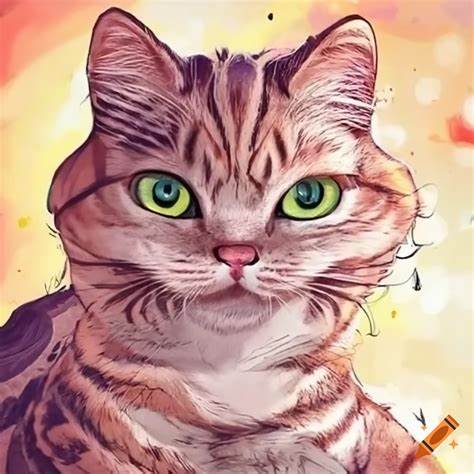Drawing is a timeless and universal form of expression. Whether you’re a seasoned artist or a beginner, understanding various techniques and styles is essential. This article focuses on drawing the A4Z_-YMTKR8= cat, a unique and specific type of feline depiction that combines elements of realism with imaginative flair.
The Concept of A4Z_-YMTKR8= Cat
drawing the A4Z_-YMTKR8= cat, The A4Z_-YMTKR8= cat is not just any cat; it represents a blend of natural feline characteristics and creative elements. This concept allows artists to explore beyond the usual boundaries of cat illustrations, adding unique features and personality to their drawings.
Materials Needed
drawing the A4Z_-YMTKR8= cat, Before diving into the drawing process, gather all necessary materials. These include quality drawing paper, pencils of various grades (HB, 2B, 4B, 6B), erasers, a sharpener, and optionally, colored pencils or markers for adding color.
Understanding Cat Anatomy
drawing the A4Z_-YMTKR8= cat, To draw any cat accurately, understanding its anatomy is crucial. Study the basic structure of a cat, focusing on the skull shape, body proportions, and muscle structure. This foundational knowledge will inform your drawing and help achieve a realistic yet stylized representation.
Initial Sketch: Basic Shapes
Start with a light sketch using basic shapes. Draw an oval for the head, circles for the eyes, a triangle for the nose, and lines for the body and tail. These initial shapes will serve as a guide for refining the drawing later.
Refining the Head
Once the basic shapes are in place, refine the head by adding details such as the ears, eyes, and nose. Pay attention to the proportions and placement of these features. The eyes should be almond-shaped, and the ears should be pointed and set wide apart.
Adding Facial Details
Next, focus on the facial details. Draw the pupils, add fur texture around the cheeks and chin, and refine the nose and mouth. Small details like whiskers and the texture of the fur around the face can add a lot of character to your drawing.
Drawing the Body
With the head refined, move on to the body. Sketch the general outline of the cat’s body, using curved lines to represent the natural flow of the cat’s posture. Ensure that the body proportions are balanced, and the limbs are correctly positioned.
Defining the Legs and Paws
Detail the legs and paws by adding muscle definition and fur texture. Pay attention to the joints and how the legs bend. Cats have distinctively flexible limbs, so capturing this flexibility in your drawing is important.
Creating the Tail
The tail is a significant feature of a cat. Draw it with a smooth, flowing line that follows the natural curve of a relaxed or alert cat. Add fur texture to the tail, making it appear fluffy and dynamic.
Adding Fur Texture
Fur texture can make a big difference in your drawing. Use short, quick strokes to create the illusion of fur. Vary the direction and length of your strokes to mimic the natural fur pattern of a cat. Pay extra attention to areas like the neck, chest, and belly where fur tends to be denser.
Detailing the Eyes
The eyes are often considered the most expressive part of a cat. Add depth and detail to the eyes by shading around the pupils and adding highlights to reflect light. This will make the eyes appear more lifelike and engaging.
Shading and Highlighting
Shading adds depth and dimension to your drawing. Use a range of pencil grades to create shadows and highlights. Focus on areas where light naturally falls and areas that would be in shadow. Blending tools like a blending stump can help achieve smooth transitions.
Incorporating Unique Features
To make your A4Z_-YMTKR8= cat stand out, incorporate unique features. This could be anything from exaggerated whiskers to an unusually patterned coat. Let your imagination guide you in adding these creative elements.
Background Elements
Consider adding background elements to your drawing. This could be a simple setting like a cozy room or an outdoor scene. Backgrounds can provide context and enhance the overall composition of your drawing.
Coloring Techniques
If you choose to add color, use colored pencils or markers. Start with light layers and gradually build up to achieve the desired intensity. Pay attention to the natural colors of a cat, but feel free to experiment with imaginative color schemes.
Final Touches
Review your drawing and add any final touches. This might include enhancing certain details, darkening shadows, or adding highlights. These final touches can make your drawing more polished and complete.
Troubleshooting Common Issues
It’s normal to encounter challenges while drawing. Common issues include proportions being off, unnatural poses, or shading that doesn’t look right. Take your time to identify and correct these issues. Sometimes stepping away from your drawing for a while can provide a fresh perspective.
Practice and Patience
Mastering the art of drawing cats, especially the A4Z_-YMTKR8= cat, requires practice and patience. Don’t be discouraged by initial difficulties. With each attempt, you’ll improve and develop your unique style.
Learning from Other Artists
Study works from other artists who specialize in drawing cats. Observe their techniques, how they handle fur texture, shading, and proportions. Learning from others can inspire you and provide new ideas for your own drawings.
Using References
References are invaluable when drawing. Use photos of real cats or other cat drawings as references. They provide a realistic basis for your work and can help you understand different poses, expressions, and fur patterns.
Digital Drawing Options
If you prefer digital art, many techniques for drawing the A4Z_-YMTKR8= cat can be adapted to digital mediums. Digital tools offer flexibility with layers, undo options, and a wide range of brushes and effects.
Sharing Your Work
Share your completed drawings with the art community. Platforms like Instagram, DeviantArt, and art forums are great places to showcase your work, get feedback, and connect with other artists. Sharing your progress can also be motivating.
Conclusion
Drawing the A4Z_-YMTKR8= cat is a rewarding experience that combines technical skill with creative expression. By following the steps outlined in this guide, you can create a unique and captivating depiction of this imaginative feline. Remember, the key to improvement is continuous practice and embracing your artistic journey. Happy drawing!







